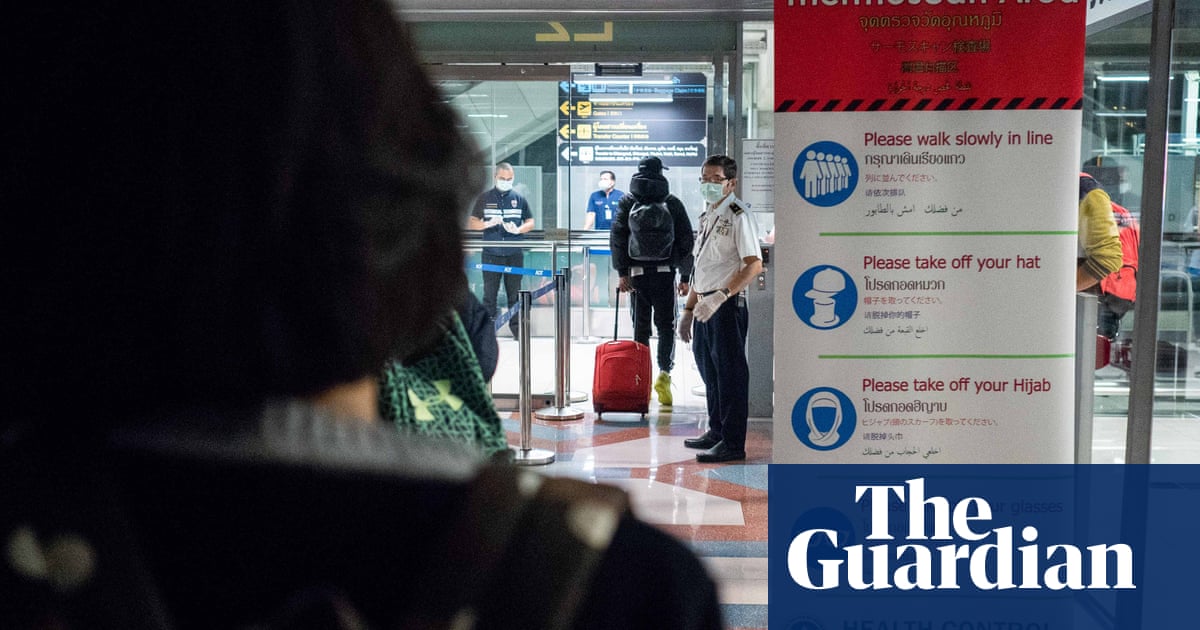Mikä estää heitä tekemästä tätä jossain muussa maassa?
Kiinnijääminen johtaisi kauppasuhteiden pilaantumiseen.
Follow along with the video below to see how to install our site as a web app on your home screen.
Note: This feature may not be available in some browsers.
Mikä estää heitä tekemästä tätä jossain muussa maassa?
Kiinnijääminen johtaisi kauppasuhteiden pilaantumiseen.
Alamaailman kauppasuhteiden pilaantumiseen? En usko. Ainoastaan jos valtio kontrolloi tuota. Heille voittoa olisi jos he pystyisivät kuppaamaan epidemiaa niin pitkään kun se jatkuu. Periaatteessa he pystyisivät aiheuttaa globaalin tilanteen missä suuri osa possuista olisi kipeänä, käyttämällä hyväkseen suhteita ja organisoitua rikollisuutta. Kaaoksessa he tekevät rahaa mustalla kaupalla.
Mikä estää heitä tekemästä tätä jossain muussa maassa?
Jos tuollaista tapahtuisi kiinalaisten tekemänä jossain muussa maassa, niin se olisi biologisen sodankäynnin piiriin kuuluvaa terrorismia tai sotaa.

China has been battling what may be a new strain of pneumonia after 59 people contracted a mysterious respiratory illness in central China, prompting fears of another Sars outbreak.
Health officials are worried about the upcoming Spring Festival in late January, when China celebrates lunar new year and millions of people will be travelling across the country to go home. Authorities have warned citizens to be on the lookout for symptoms like fever, difficulty breathing or body ache.
On Tuesday, Hong Kong’s chief executive, Carrie Lam, said health officials had “strengthened measures on all borders”. Since Monday, all travellers arriving on trains from Wuhan have been subjected to body temperature checks.
Health authorities in Wuhan first reported 27 cases of an unidentified pneumonia-like illness at the end of December, a figure that jumped to 59 as of Sunday. The patients, seven of whom are in critical condition, have been quarantined. There have been no reported deaths.
Authorities said epidemiologists have ruled out the possibility of Sars, the deadly respiratory virus that spread to at least 37 countries and killed more than 800 people in 2002 and 2003, an outbreak made worse by a government cover-up.


A cluster of more than 50 pneumonia cases in the central Chinese city of Wuhan may be due to a newly emerging member of the family of viruses that caused the deadly Sars and Mers outbreaks, according to the World Health Organization.
While the UN health agency said it needed more comprehensive information to confirm precisely the type of pathogen causing the infections, it said a new coronavirus was a possibility.
Coronaviruses are a large family of viruses that can cause infections ranging from the common cold to Severe acute respiratory syndrome (Sars). Some of the virus types cause less severe disease, while some – like the one that causes Middle East respiratory syndrome (Mers) – are far more severe.
“The initial information about the cases of pneumonia in Wuhan ... pointed to a coronavirus as a possible pathogen causing this cluster,” the WHO said in a statement.



 arstechnica.com
arstechnica.com
A never-before-seen virus that sparked an outbreak of viral pneumonia in the Chinese city of Wuhan has now killed one person and spread to Thailand via a sick traveler.
On Saturday, January 11, officials in Wuhan reported that a 61-year-old man died January 9. Testing indicated he was carrying the virus, which researchers have confirmed is a novel strain of coronavirus.
His is the first recorded death in the outbreak, which erupted last month in Wuhan and has been linked to a live-animal market there. Officials said that the man had been admitted to the hospital with respiratory failure and severe pneumonia. However, they also noted that he had other health issues, namely abdominal tumors and chronic liver disease.
Since officially linking the novel coronavirus to the outbreak, officials in Wuhan have confirmed 41 cases of pneumonia from the viral newcomer. Of those, six are considered severe, and seven cases have been treated and discharged. That tally is down from 59 outbreak cases reported earlier last week, before the viral cause was known.
The sick traveler in Thailand marks the first time that the virus has been confirmed outside of China.
The female traveler, who is also 61 years old, was identified by Thai authorities on January 8 and placed under quarantine, according to the World Health Organization. Genetic tests indicated that she carried the same strain of coronavirus isolated from patients in Wuhan.

 arstechnica.com
arstechnica.com
Japani on vahvistanut ensimmäisen infektiotapauksen, jonka aiheuttajaksi arvellaan tuntematonta koronaviruksen tyyppiä, kertoo uutistoimisto Reuters.
Japanin terveysministeriön lausunnon mukaan kolmekymppinen mies Kanagawan alueelta antoi postitiivisen testituloksen. Sairastunut oli ollut Wuhanissa, missä useilla kymmenillä ihmisillä on havaittu keuhkokuumeen kaltaisia oireita, joiden aiheuttajaksi on epäilty uutta koronaviruskantaa.
Yhdysvaltain tautikeskus (the U.S. Centers for Disease Control and Prevention) kehottaa alueella matkustavia välttämään kontakteja eläinten kanssa, eläintoreja ja eläinperäisiä tuotteita.
Thaimaan terveysviranomaiset ilmoittavat tehostavansa lentokentille saapuvien matkustajien tarkkailua, kun maahan odotetaan saapuvan 800 000 kiinalaista turistia Kiinalaisen uudenvuoden vapaiden alla.
Maailman terveysjärjestö WHO on arvioinut, että uusi virus voi levitä ja varoittanut sairaaloita ympäri maailman.
Koronavirukset ovat laaja virusten perhe, joka voi aiheuttaa infektiota tavallisesta flunssasta vakaviin hengitystieinfektioihin, kuten SARS ja MERS. SARS aiheutti epidemian 2000-luvun alussa.
Japanilainen potilas palasi Wuhanista tässä kuussa kuumeisena ja otettiin sairaalahoitoon. Hän pääsi sairaalasta keskiviikkona, kun hänen oireensa olivat helpottaneet, terveysviranomaiset ilmoittivat.
A second person has died from pneumonia in the central Chinese city of Wuhan after an outbreak of a previously unknown virus, local health authorities have said.
The 69-year-old man had been admitted to hospital with abnormal renal function and severe damage to multiple organs, the Wuhan municipal health commission announced. He died on 15 January.
At least 41 people have been diagnosed with pneumonia linked to the new virus, prompting authorities in Hong Kong to step up detection measures, including temperature checkpoints for inbound travellers.
Preliminary lab tests cited by state media showed the pathogen could be from a new type of coronavirus, a large family of viruses that can cause infections ranging from the common cold to deadly severe acute respiratory syndrome (Sars).
On Thursday Japan confirmed a man in his 30s had been infected with the virus, and a Chinese woman was quarantined in Thailand with a mystery strain of coronavirus. The World Health Organisation (WHO) has warned a wider outbreak is possible.
On Friday, Thailand confirmed a second case of the virus. A 74-year-old Chinese woman from Wuhan had been quarantined since her arrival on Monday and was found to be infected with the newly identified coronavirus, said Sukhum Karnchanapimai, permanent secretary of the Public Health Ministry.
Sukhum also urged Thais to remain calm, saying that there was no outbreak in the country.

Kansainväliset tartuntatautien asiantuntijat arvioivat, että Kiinassa tavatun uuden virustyypin tartuntojen todellinen määrä on todennäköisesti huomattavasti suurempi kuin tähän mennessä vahvistettujen tartuntojen määrä.
Perjantaina julkaistu tutkimus arvioi (siirryt toiseen palveluun) todelliseksi tartuntojen määräksi liki 1 700. Kiinan viranomaiset puolestaan ovat kertoneet, että noin 50 ihmistä on saanut vahvistetusti tartunnan tähän mennessä.
Imperial College London -yliopiston globaalien tartuntatautien tutkimusyksikössä tehdyn laskelman perusteena on käytetty virustyyppiin liittyvää epidemiamallinnusta sekä tietoja tartunta-alueen väestöstä, alueen lentoyhteyksistä ja ulkomailla tavatuista tartunnoista.
– Olen huomattavasti enemmän huolissani nyt kuin mitä olin viikko sitten, sanoi tutkimuksessa mukana ollut professori ja epidemiatutkija Neil Ferguson Britannian yleisradioyhtiö BBC:n mukaan. (siirryt toiseen palveluun)
Imperal College London toimii muun muassa Britannian hallituksen ja Maailman terveysjärjestön neuvonantajana.
Kiinan viranomaiset eivät ole kommentoineet tutkijoiden laskelmia.
Ennestään tuntematon virus aiheuttaa keuhkokuumeen kaltaisia oireita. Viruksen uskotaan olevan uusi koronaviruksen tyyppi. Tautiin on kuollut tähän mennessä kaksi ihmistä.
Maailman terveysjärjestö WHO on aiemmin varoittanut, että tartunnan leviäminen laajemmalle on mahdollista.
Kiinassa alkaa uudenvuoden lomakausi ensi viikolla ja tauti saattaa levitä muualle matkailijoiden mukana.

Prof Neil Ferguson and colleagues, from the MRC Centre for Global Infectious Disease Analysis at Imperial, calculated that the number of cases in Wuhan may be more than 1,700. “It is likely that the Wuhan outbreak of a novel coronavirus has caused substantially more cases of moderate or severe respiratory illness than currently reported,” they said in a report.
The report said all hospitalised cases of pneumonia or severe respiratory disease in the Wuhan area and other well-connected Chinese cities should be investigated.
They cautioned that because of the unknown factors in their estimates, the case numbers could be anywhere from 190 to over 4,000. But in a tweet, they said that “the magnitude of these numbers suggests that substantial human-to-human transmission cannot be ruled out. Heightened surveillance, prompt information sharing and enhanced preparedness are recommended.”
Their calculation is based on the two people in Thailand and one in Japan who were diagnosed with the virus. Based on flight and population data, said Ferguson, “there is only a 1 in 574 chance that a person infected in Wuhan would travel overseas before they sought medical care. This implies there might have been over 1,700 (3 x 574) cases in Wuhan so far.”
US authorities announced they would begin screening passengers arriving from Wuhan on direct or connecting flights at three airports: San Francisco, New York’s JFK and Los Angeles. Authorities in Hong Kong, Thailand, Malaysia, Singapore and South Korea, Indonesia and the Philippines have all stepped up screening.
In Australia, the New South Wales and Victorian governments both issued alerts to health professionals about the virus, but there was no specific screening for the virus or change to travel advice.

Based on currently available information, WHO does not recommend any restriction of travel or trade. Countries are encouraged to continue strengthening their preparedness for health emergencies in line with the International Health Regulations (2005).Standard recommendations to prevent infection spread include regular hand washing, covering mouth and nose when coughing and sneezing, thoroughly cooking meat and eggs. Avoid close contact with anyone showing symptoms of respiratory illness such as coughing and sneezing.

A mysterious Sars-like virus has spread around China – including to Beijing – fuelling anxiety of a major outbreak in the country as millions begin travelling for the lunar new year.
Authorities reported 139 new cases of the new strain of coronavirus over the weekend, more than doubling the total number of infected patients since the virus was first detected last month in the central Chinese city of Wuhan.
Three people have died, and at least three cases have been reported overseas: two in Thailand and one in Japan. On Monday, media in South Korea said a woman who had travelled from China had also tested positive.
Cases have been detected in Beijing, Guangdong and Zhejiang provinces, Chinese authorities said on Monday, heightening fears ahead of the lunar new year holiday, when more than 400 million Chinese citizens are expected to travel domestically and internationally.

The World Health Organization has said an animal source was “the most likely primary source” of the outbreak, with “some limited human-to-human transmission occurring between close contacts”. Researchers worry the number of infections has been severely underestimated.
The WHO said it would convene an emergency meeting in Geneva on Wednesday to discuss whether the new coronavirus constituted an international health emergency.
Xi Chen, an assistant professor at the Yale School of Public Health, said the likelihood of human-to-human transmission had appeared large given how many cases were confirmed. “It’s hard to see all these cases coming from animals at the same market,” Chen said.
For weeks, the only reported cases were in Wuhan and areas outside mainland China, prompting many people to question whether other cities were simply not reporting or testing for the virus. Some internet users joked the virus appeared to be “patriotic” by only spreading beyond China’s borders.
Chen said the high cost of testing for diagnosis may have contributed to underreporting.

Authorities have still not identified the source of the infection, which further complicates the government’s ability to contain the outbreak. The Huanan seafood market, where thousands of traders sold products, has been closed since 1 January. But some of the detected cases are patients with no history of visiting the market.
“What concerns me is the source of infection. We have no idea. That’s the most important thing. Without knowing that we don’t know the harm, how hard it can be,” Chen said.
Others fear that authorities have not moved quickly enough to contain the spread of the virus or educate the public. In Wuhan, temperature checkpoints have been installed at the airport and at train stations and bus terminals since 14 January, about five weeks after the virus was first detected.
Observers and residents worry about the possibility of a cover-up worsening the outbreak, as was the case with Sars in 2003.
Some residents in Wuhan have been told not to speak to media. The official Weibo account of Wuhan police said on 1 January that eight internet users who spread false information online “causing adverse social impacts” had been dealt with “according to the law”.
But Chinese health officials have made improvements since the Sars episode. In response to a bird flu outbreak in 2013, authorities quickly worked with the World Health Organization and the US Centers for Disease Control and Prevention. Fresh food markets were shut down but the outbreak was exacerbated by poultry sales into smaller, less-regulated markets.
Kiinassa koronavirustartunnan saaneiden määrä on kohonnut lähes kolmeensataan, kertovat viranomaiset. Uusia vahvistettuja tartuntatapauksia on noin 80.
Viranomaiset kertoivat aiemmin, että virus on vaatinut kuudennen kuolonuhrin.
Terveyden ja hyvinvoinnin laitoksen johtava asiatuntija Jussi Sane kertoo Ylelle, että Suomessa seurataan virustartunnan tilannetta tarkasti.
– Laboratoriovalmiutta ja toimintamalleja on kehitetty.
Sanen mukaan epidemiariski Euroopassa on erittäin pieni, eikä Suomessa ole syytä ryhtyä radikaaleihin toimenpiteisiin.
– Tällä hetkellä THL ei suosittele erityisiä toimia lentokentille tai matkustajille.
Maailman terveysjärjestö WHO järjestää huomenna Sveitsissä hätäkokouksen koronaviruksen leviämisen takia.
Kiinan terveysneuvoston mukaan yli 900 ihmistä on yhä tarkkailussa.
Uusi virus kuuluu samaan sukuun kuin 2000-luvun alkupuolella levinneet sars- ja mers-virukset. Sars-virukseen menehtyi arviolta 800 ihmistä eri puolilla maailmaa.
China is on high alert as a new strain of coronavirus – first detected in Wuhan – spreads across the country. If hospitals are not screening for the virus then the number of cases, and deaths, could be much higher than those cited in official reports.
Authorities reported three more deaths on Tuesday: an 89-year-old male, a 66-year-old male and a 48-year-old female. The government has confirmed 291 cases, with 270 of them in Hubei province, of which Wuhan is the capital.
Cases have been confirmed in Beijing, Shanghai, and Guangdong province – and suspected cases have been flagged in 13 provinces across the country – many of them hundreds of miles away from Wuhan. Fifteen health workers in Wuhan have also been infected, according to authorities.

The number of confirmed infections is likely to have been underestimated, according to international public health experts, who say there could be as many as 1,700 cases.
On the microblog Weibo, another Wuhan resident posted images of her diagnosis of viral pneumonia and described the long queues of patients with similar symptoms late on Monday night, none of whom appeared to have been tested for coronavirus. “Could all these people suddenly have viral pneumonia?” she said.
Another Weibo user complained earlier this month that his father showed the symptoms of the virus but was sent home from the hospital without any screening. The post later disappeared.
The World Health Organization has said the recent rise in cases is a sign authorities are now more aggressively screening for the virus. It will consider declaring an international public health emergency – as it did with swine flu and Ebola – on Wednesday.
The Chinese political body responsible for law and order said on Tuesday that lower-ranking officials who covered up the spread of the virus would “be nailed on the pillar of shame for eternity”.
During the Sars outbreak in the early 2000s, China initially withheld information about it from the public and vastly underreported cases of infection. The virus, which was also caused by a coronavirus, killed 774 people.
| Biohazard level | 0/4 - Cannot be classified |
|---|---|
| Biohazard description | Cannot be classified as biohazard |
| Disease, agent name | new coronavirus |
 virologydownunder.com
virologydownunder.com
